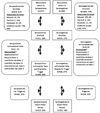Ten-year incidence of Chagas cardiomyopathy among asymptomatic Trypanosoma cruzi-seropositive former blood donors
- PMID: 23393012
- PMCID: PMC3643805
- DOI: 10.1161/CIRCULATIONAHA.112.123612
Ten-year incidence of Chagas cardiomyopathy among asymptomatic Trypanosoma cruzi-seropositive former blood donors
Abstract
Background: Very few studies have measured disease penetrance and prognostic factors of Chagas cardiomyopathy among asymptomatic Trypanosoma cruzi-infected persons.
Methods and results: We performed a retrospective cohort study among initially healthy blood donors with an index T cruzi-seropositive donation and age-, sex-, and period-matched seronegatives in 1996 to 2002 in the Brazilian cities of São Paulo and Montes Claros. In 2008 to 2010, all subjects underwent medical history, physical examination, ECGs, and echocardiograms. ECG and echocardiogram results were classified by blinded core laboratories, and records with abnormal results were reviewed by a blinded panel of 3 cardiologists who adjudicated the outcome of Chagas cardiomyopathy. Associations with Chagas cardiomyopathy were tested with multivariate logistic regression. Mean follow-up time between index donation and outcome assessment was 10.5 years for the seropositives and 11.1 years for the seronegatives. Among 499 T cruzi seropositives, 120 (24%) had definite Chagas cardiomyopathy, and among 488 T cruzi seronegatives, 24 (5%) had cardiomyopathy, for an incidence difference of 1.85 per 100 person-years attributable to T cruzi infection. Of the 120 seropositives classified as having Chagas cardiomyopathy, only 31 (26%) presented with ejection fraction <50%, and only 11 (9%) were classified as New York Heart Association class II or higher. Chagas cardiomyopathy was associated (P<0.01) with male sex, a history of abnormal ECG, and the presence of an S3 heart sound.
Conclusions: There is a substantial annual incidence of Chagas cardiomyopathy among initially asymptomatic T cruzi-seropositive blood donors, although disease was mild at diagnosis.
Figures


Comment in
-
Infection with Trypanosoma cruzi and progression to cardiomyopathy: what is the evidence and is the tide finally turning?Circulation. 2013 Mar 12;127(10):1095-7. doi: 10.1161/CIRCULATIONAHA.113.000891. Epub 2013 Feb 7. Circulation. 2013. PMID: 23393009 No abstract available.
-
Letter by Rassi and Rassi regarding article, "Ten-year incidence of Chagas cardiomyopathy among asymptomatic, Trypanosoma cruzi-seropositive former blood donors".Circulation. 2013 Aug 27;128(9):e135. doi: 10.1161/CIRCULATIONAHA.113.002384. Circulation. 2013. PMID: 23979634 No abstract available.
-
Letter by Bestetti and Cardinalli-Neto regarding article, "Ten-year incidence of Chagas cardiomyopathy among asymptomatic, Trypanosoma cruzi-seropositive former blood donors".Circulation. 2013 Aug 27;128(9):e136. doi: 10.1161/CIRCULATIONAHA.113.003531. Circulation. 2013. PMID: 23979635 No abstract available.
-
Response to letters regarding article, "Ten-year incidence of Chagas cardiomyopathy among asymptomatic, Trypanosoma cruzi-seropositive former blood donors".Circulation. 2013 Aug 27;128(9):e137-8. doi: 10.1161/CIRCULATIONAHA.113.004018. Circulation. 2013. PMID: 23979636 No abstract available.
References
-
- Rassi A, Jr, Rassi A, Marin-Neto JA. Chagas disease. Lancet. 2010;375:1388–1402. - PubMed
-
- Lescure FX, Le Loup G, Freilij H, Develoux M, Paris L, Brutus L, Pialoux G. Chagas disease: changes in knowledge and management. Lancet Infect Dis. 2010;10:556–570. - PubMed
-
- Cantey PT, Stramer SL, Townsend RL, Kamel H, Ofafa K, Todd CW, Currier M, Hand S, Varnado W, Dotson E, Hall C, Jett PL, Montgomery SP. The United States Trypanosoma cruzi Infection Study: evidence for vector-borne transmission of the parasite that causes Chagas disease among United States blood donors. Transfusion. 2012;52:1922–1930. - PubMed
-
- Custer B, Agapova M, Bruhn R, Cusick R, Kamel H, Tomasulo P, Biswas H, Tobler L, Lee TH, Caglioti S, Busch M. Epidemiologic and laboratory findings from 3 years of testing United States blood donors for Trypanosoma cruzi. Transfusion. 2012;52:1901–1911. - PubMed
-
- Rassi A, Jr, Rassi A, Little WC, Xavier SS, Rassi SG, Rassi AG, Rassi GG, Hasslocher-Moreno A, Sousa AS, Scanavacca MI. Development and validation of a risk score for predicting death in Chagas’ heart disease. N Engl J Med. 2006;355:799–808. - PubMed
Publication types
MeSH terms
Grants and funding
LinkOut - more resources
Full Text Sources
Other Literature Sources
Medical

